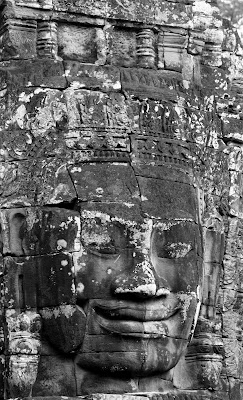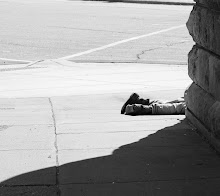 "Ankor" means City in Khmer.
"Ankor" means City in Khmer.The Ankor complex in Cambodia is a Unesco World Heritage site and within its boundaries houses roughly a thousand Temples dating back as far as 800AD. It was founded by the Khmer Hindu King Jayavarman who declared himself the Universal Monarch and "God King" and served as the capital of the Khmer Empire until the 15th century when it was sacked by Thai invaders. Researchers using satellite pictures and excavations have concluded that Ankor was in its time the largest pre industrial city in the world and at its height housed over 1 million people with an urban sprawl of 3000 sq kms. All this came as a surprise to me. I thought before going that it was one temple complex, Ankor Wat, and that it was Buddhist.
Over time Buddhism took hold in the region and the temples were converted but it's origins and the majority of its existence was Hindu.
 The sheer scale of the area was a surprise. Today the main Ankor temples reside in a 400km National park with the majority of the most important complexes within striking distance (4 kms) from Siem Reap. Ankor Wat, the most famous temple of all is the biggest religious building in the world and photographed at dawn is the iconic symbol of the ancient Khmer Kingdom.
The sheer scale of the area was a surprise. Today the main Ankor temples reside in a 400km National park with the majority of the most important complexes within striking distance (4 kms) from Siem Reap. Ankor Wat, the most famous temple of all is the biggest religious building in the world and photographed at dawn is the iconic symbol of the ancient Khmer Kingdom.  Of all the temples in the Ankor region, three provide the "essential" tourist snaps.
Of all the temples in the Ankor region, three provide the "essential" tourist snaps.Ankor Wat ( above), Ta Som below:
 and my favorite, Ta Prohm.
and my favorite, Ta Prohm.Very Raiders of the Lost Ark.
Or should I say Tomb Raider ( part of which was filmed here)
 Siem Reap is the jumping off point for Ankor. It has a shiny new airport and is easily reached via Bangkok (50 mins flt). You can get a Visa on arrival for $20, but be sure to come armed with a passport sized photo otherwise you'll cool your heels for the time it takes to process everyone else and likely be soaked an extortionate amount to get your picture taken.
Siem Reap is the jumping off point for Ankor. It has a shiny new airport and is easily reached via Bangkok (50 mins flt). You can get a Visa on arrival for $20, but be sure to come armed with a passport sized photo otherwise you'll cool your heels for the time it takes to process everyone else and likely be soaked an extortionate amount to get your picture taken.The currency for tourists ( and everyone else as far as I could see) is US $'s, but apart from $30 or so in small notes, don't bring a wad of cash. Bills above $5 are worthless unless they are in pristine condition and will be refused if they look tatty. ATMs in town issue crisp "brand new" bills....something I found surreal. Change is given to you in combination of $'s and local currency in place of coins.
£1= 4000 local units ( Riels I think they're called).
Its best to arrange a pick up from your hotel as there have been reports of some nastiness with the airport cabs. It will cost about $10.
By the time you head home you'll have got the hang of it and will probably be delivered back to the airport by tuk tuk for $4-$5.
"Siem Reap" roughly translates into "Victory over Siam".
Though the Khmer Region historically encompassed a big slice of Thailand, the Thais controlled Ankor and Siem Reap for over 100 years until the French took control in 1907.
In the 1960s celebrities from Charlie Chaplin to Jackie Kennedy beat a path to the town to visit Ankor until the days of Pol Pot and the Khmer Rouge threw all of Cambodia into the dark nightmare years of the "Killing Fields".
Millions lost their lives.
Siem Reap has two main markets. The "Old Market" is in the center of town and is a working hub selling food ( meat and veg) as well as the usual tourist "stuff".




Apart from the scary food section, there are stalls upon stalls selling Cambodian silk scarves, ties and bedspreads. It's very cheap but you need to bargain hard, with a smile and sense of humour. Even though you don't really need any of this stuff , you'll be surprised how much $20 will get you and the hour or so wandering around is hard to beat for fun. In terms of accommodation Siem Riep has all levels of the spectrum. If a guest house is your thing and air can is not essential then you're looking at about $12 a night. Four star accommodation runs between $50-$100 and there are a couple of 5 star operations running $250+. Food and drink is cheap and runs from Khumer curries ( think Thai) , to burgers and pizzas. You can eat well for under $5 regardless of what you choose. The main strip is a road called "Pub Street". Its a pedestrian thoroughfare at night and though pretty lively, felt a bit like a frat party to me.
In terms of accommodation Siem Riep has all levels of the spectrum. If a guest house is your thing and air can is not essential then you're looking at about $12 a night. Four star accommodation runs between $50-$100 and there are a couple of 5 star operations running $250+. Food and drink is cheap and runs from Khumer curries ( think Thai) , to burgers and pizzas. You can eat well for under $5 regardless of what you choose. The main strip is a road called "Pub Street". Its a pedestrian thoroughfare at night and though pretty lively, felt a bit like a frat party to me.
Ugh.
A pitcher of local beer is circa $3.50 and a bottle of Heineken runs a cheap $2.
I found myself drinking smoothies and fruit juices everyday for less than the cost of a chocolate bar in the UK.
Smoothies?
This is not tough travel.
The coffee sucked though. It's impossible to get a decent cup of joe in Cambodia. There are 3 million people in Cambodia and 4 million land mines still scattered around the countryside. Every day people are maimed or killed.
There are 3 million people in Cambodia and 4 million land mines still scattered around the countryside. Every day people are maimed or killed. Children and farmers seem to be bearing the brunt of the carnage. In the remoter parts of the Ankor reserve it is advisable to stay on the established paths as not all of the tourist areas have been cleared. As you can see below they're not easy to spot.
Children and farmers seem to be bearing the brunt of the carnage. In the remoter parts of the Ankor reserve it is advisable to stay on the established paths as not all of the tourist areas have been cleared. As you can see below they're not easy to spot.




































 This post has taken an ungodly time to put up so I'm done for now.
This post has taken an ungodly time to put up so I'm done for now.
8 comments:
Great pictures Terry! Definitively a place I'll visit soon. It's beautiful and I imagine it would be great to find a good spot and meditate in the atmosphere there.
It's also amazing to think about the amount of creativity, energy and human lives people were willing to spend to build those things ...
Hey Kjell great to see you still visit the blog.
All my old faithful friends seem to have abandoned it!
As far as meditation in the jungle....errrr think of Dengue fever from the mossies and dehydration from the humidity,
unless the sword Tia Chi dude that you are is above such worries. Also careful where you plonk your ass down to contemplate inner peace as the place is infested with land mines,,,,,,
All...? Hrrumph.
Yours faithfully,
TR-HW
;-)
Who put them mines there?!
A very interesting ancient place... people (kids) strike me as beautiful!
Lennie
TR-HW
You are my most faithful reader and comment machine.....
Land mines: Who put them there?
Khmer Rouge
Yanks
Vietnam
Cambodian Govt forces
The land mines were made in China, the US, Russia and Canada the UK .
Only the Yanks,Canadians and Brits (from the countries of manufacture) are helping to clean them up. There is a lot of bitterness on the part of Cambodians towards Russia and China in this regard. There used to be 7 million scattered throughout the country- thats more than 2 for every man, woman and child in the country.
You sweet-talker you.
It is said (and I don't know if this is true) that before the land mines the women walked behind the men, and now they walk in front...
It's not just a SE Asian problem, Bosnia is heavily peppered with mines following the war in the early 90's.
TR-HW
Wonderful photographs of the temples and the children! Thanks.
Trip tip:
ANGKOR, CAMBODIA
THE BUILD-UP Angkor boasts some of the most jaw-dropping Buddhist monuments in Southeast Asia. The dozens of spectacular temples here are crowned by the peerless Angkor Wat – the site’s largest monument – in a memorably atmospheric setting among gnarled jungles and glass-like paddy fields.
THE REALITY Unfortunately, there’s no escaping the crowds here. The days when Angkor was a remote and challenging destination are sadly long gone.
The temples are now firmly on the international sightseeing circuit, making it hard to appreciate their majestic architecture and profound religious significance in anything approaching peace and quiet.
THE ALTERNATIVE Escape the crowded temples of Angkor and head to the equally spectacular but far less touristy Borobudur, Indonesia – one of the true wonders of the ancient Buddhist world
Post a Comment